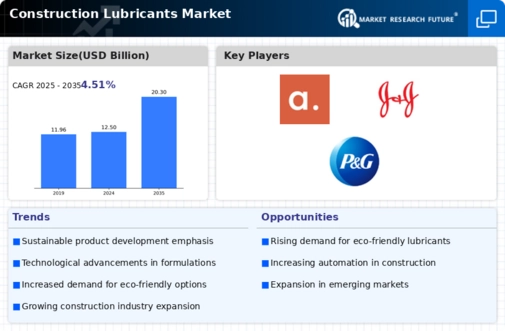Market Growth Projections
The Global Construction Lubricants Market Industry is projected to experience substantial growth, with estimates indicating a market size of 12.5 USD Billion in 2024 and a potential increase to 20.3 USD Billion by 2035. This growth trajectory suggests a compound annual growth rate (CAGR) of 4.51% from 2025 to 2035. Such projections highlight the increasing importance of lubricants in construction, driven by factors such as technological advancements, rising infrastructure investments, and the growing emphasis on sustainability. These figures reflect a robust outlook for the industry, indicating that construction lubricants will play a crucial role in supporting the evolving needs of the construction sector.
Growth in Emerging Markets
Emerging markets are becoming pivotal in shaping the Global Construction Lubricants Market Industry. Countries in Asia-Pacific and Latin America are witnessing rapid urbanization and industrialization, leading to increased construction activities. This growth is supported by government initiatives aimed at improving infrastructure and housing. As these regions develop, the demand for construction lubricants is expected to surge, contributing to the overall market expansion. The projected market size of 20.3 USD Billion by 2035 underscores the potential of these emerging markets in driving future growth in the construction lubricants sector.
Rising Infrastructure Development
The Global Construction Lubricants Market Industry is experiencing growth driven by the increasing demand for infrastructure development across various regions. Governments worldwide are investing heavily in infrastructure projects, including roads, bridges, and buildings, to support urbanization and economic growth. For instance, the global construction market is projected to reach 12.5 USD Billion in 2024, reflecting a robust investment climate. This trend is likely to continue, as infrastructure development is essential for enhancing connectivity and supporting economic activities, thereby boosting the demand for construction lubricants.
Technological Advancements in Lubricants
Innovations in lubricant formulations and technologies are propelling the Global Construction Lubricants Market Industry forward. Manufacturers are developing advanced synthetic lubricants that offer superior performance, longer service life, and enhanced protection for construction equipment. These advancements not only improve operational efficiency but also reduce maintenance costs for construction companies. As a result, the adoption of these high-performance lubricants is increasing, which is expected to contribute to the market's growth. The anticipated CAGR of 4.51% from 2025 to 2035 indicates a strong trend towards embracing technological advancements in lubricant solutions.
Increased Equipment Usage in Construction
The rising utilization of heavy machinery and equipment in construction projects is a significant driver for the Global Construction Lubricants Market Industry. As construction activities become more complex and demanding, the reliance on advanced machinery increases, necessitating the use of high-quality lubricants to ensure optimal performance and longevity. This trend is particularly evident in large-scale projects where equipment downtime can lead to substantial financial losses. Consequently, the demand for effective lubricants that can withstand harsh operating conditions is likely to grow, further propelling the market forward.
Environmental Regulations and Sustainability
The Global Construction Lubricants Market Industry is influenced by stringent environmental regulations that promote the use of eco-friendly lubricants. Governments are increasingly mandating the adoption of sustainable practices in construction, leading to a shift towards biodegradable and non-toxic lubricants. This trend is driven by the need to minimize environmental impact and comply with regulations aimed at reducing pollution. As construction companies seek to align with these regulations, the demand for environmentally friendly lubricants is likely to rise, thereby fostering growth in the market. This shift towards sustainability may also enhance the reputation of construction firms.




